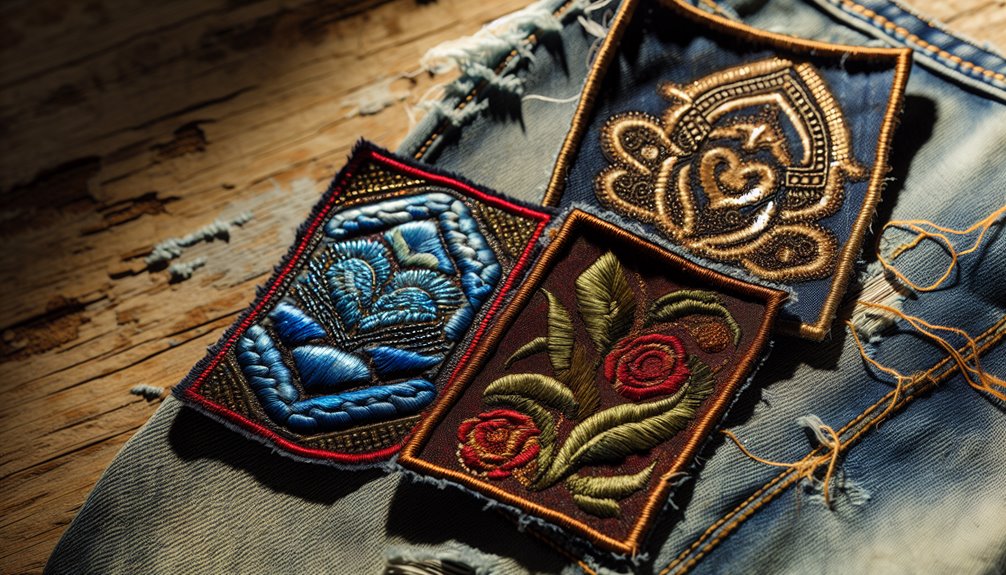The best vintage-inspired embroidered patch design techniques include chain stitch embroidery, satin-fill Americana, and distressed variegated threading. Chain stitch creates dimensional texture through overlapping loops, essential for authentic mid-century emblems. Satin stitching produces smooth color blocking with vibrant hues typical of 1950s designs. Distressed variegated threading incorporates strategic thread tension manipulation, color variation, and intentional fraying to simulate weathered character. These methods transform modern creations into pieces with historical richness that collectors immediately recognize.
Chain Stitch Heritage: Recreating Mid-Century Texture and Dimension
Although chain stitch embroidery has been used for centuries across cultures, its golden era in patch design emerged during the mid-20th century when it became the signature technique for automotive, motorcycle, and sports team emblems.
The distinctive raised texture created by overlapping loops gives patches a three-dimensional quality that modern machine embroidery often fails to replicate.
To achieve authentic mid-century motifs, crafters should master the chain stitch coaching technique. This technique involves laying down a foundation line and building upon it with parallel stitches.
This method creates the bold outlines characteristic of vintage patches. The chenille variation, popular in varsity letters, requires specialized equipment but delivers unmistakable texture.
Beginning embroiderers should practice on medium-weight fabric stabilized in a hoop before attempting work on traditional felt backings.
Satin-Fill Americana: Capturing 1950s Bold Color Blocking
While chain stitch defined mid-century patch outlines, the satin stitch emerged as the cornerstone technique for creating the vibrant color blocking characteristic of 1950s Americana patches. This method features parallel threads placed side by side, producing a smooth satin sheen that reflects light uniformly across solid areas.
Designers of the era embraced bold palettes—cherry reds, royal blues, and golden yellows—that evoked patriotic themes and roadside Americana.
To recreate this aesthetic, modern crafters should maintain consistent thread tension to prevent puckering, which can distort the flat surface necessary for an authentic vintage appearance.
When implementing color blocking, sharp shifts between hues create the definitive look of mid-century patches.
Machine embroiderers should select proper stabilizers to support densely stitched areas, while hand-embroiderers benefit from using shorter thread lengths to maintain the characteristic smooth finish.
Distressed Variegated Threading: Achieving Authentic Worn Patina Effects
Unlike the pristine appearance of traditional embroidery, authentic vintage patches display a weathered character that modern crafters must deliberately recreate through specialized techniques. Achieving distressed aesthetics requires strategic manipulation of thread tension, density, and color variation.
| Technique | Effect | Materials | Difficulty |
|---|---|---|---|
| Thread Skipping | Worn texture gaps | Cotton floss | Moderate |
| Color Fading | Sun-bleached look | Variegated thread | Advanced |
| Intentional Fraying | Edge degradation | Wool blends | Easy |
| Sandpaper Abrasion | Surface wear | Fine-grit paper | Moderate |
The vintage texture emerges through layering processes rather than single-pass embroidery. Crafters should first establish a solid foundation with traditional stitching before applying aging techniques. This calculated degradation transforms pristine work into pieces with apparent history, creating the coveted patina that collectors and enthusiasts recognize as authentically vintage-inspired.
These time-tested embroidery techniques offer more than just nostalgic appeal—they connect us to the rich history of textile craftsmanship. However, mastering vintage-inspired patch design requires patience and practice. Will your next project feature the dimensional texture of chain stitching, the bold color blocking of satin-fill, or the authentic worn look of distressed threading? The answer may determine whether your creation becomes a passing experiment or a cherished heirloom for generations to come.

